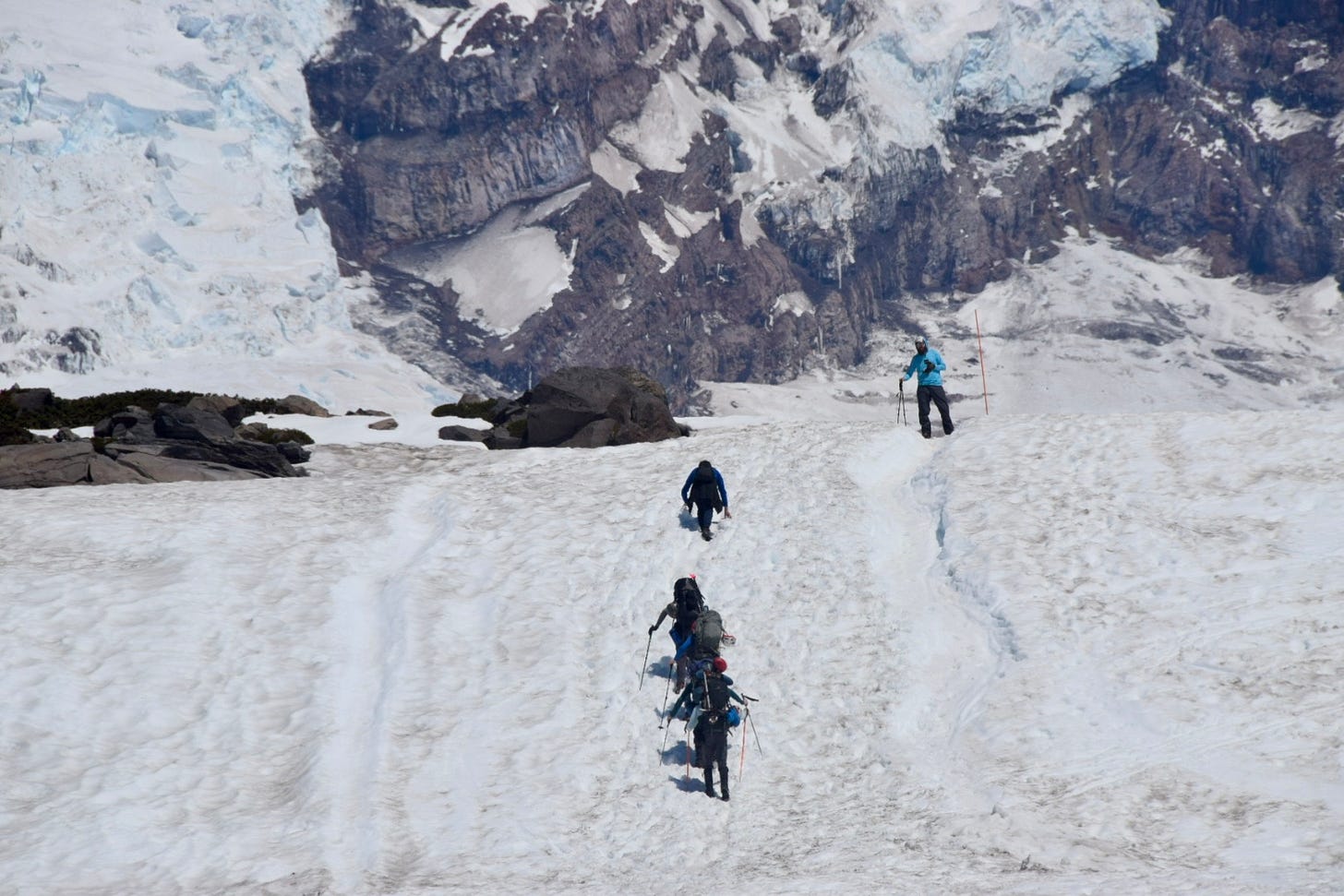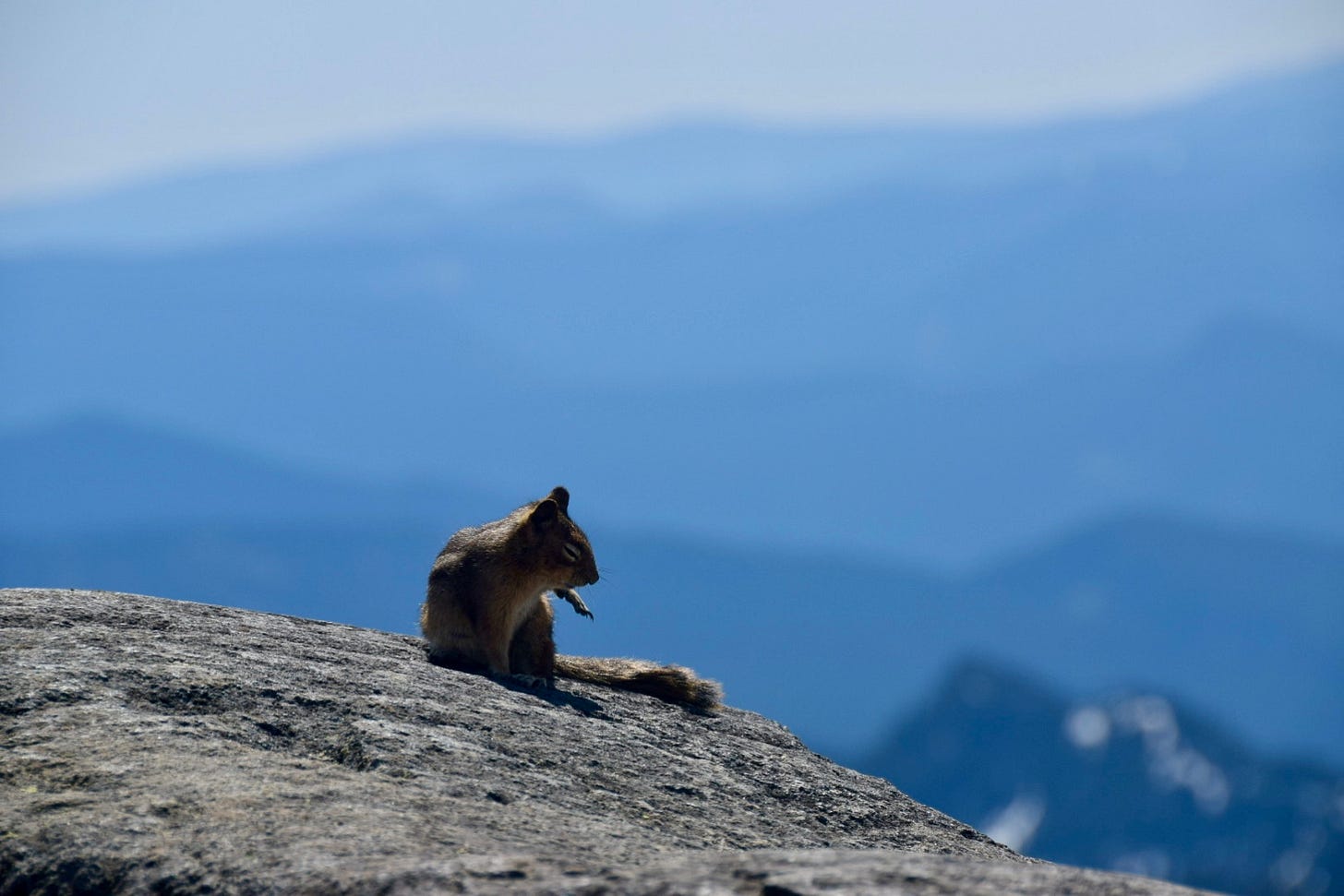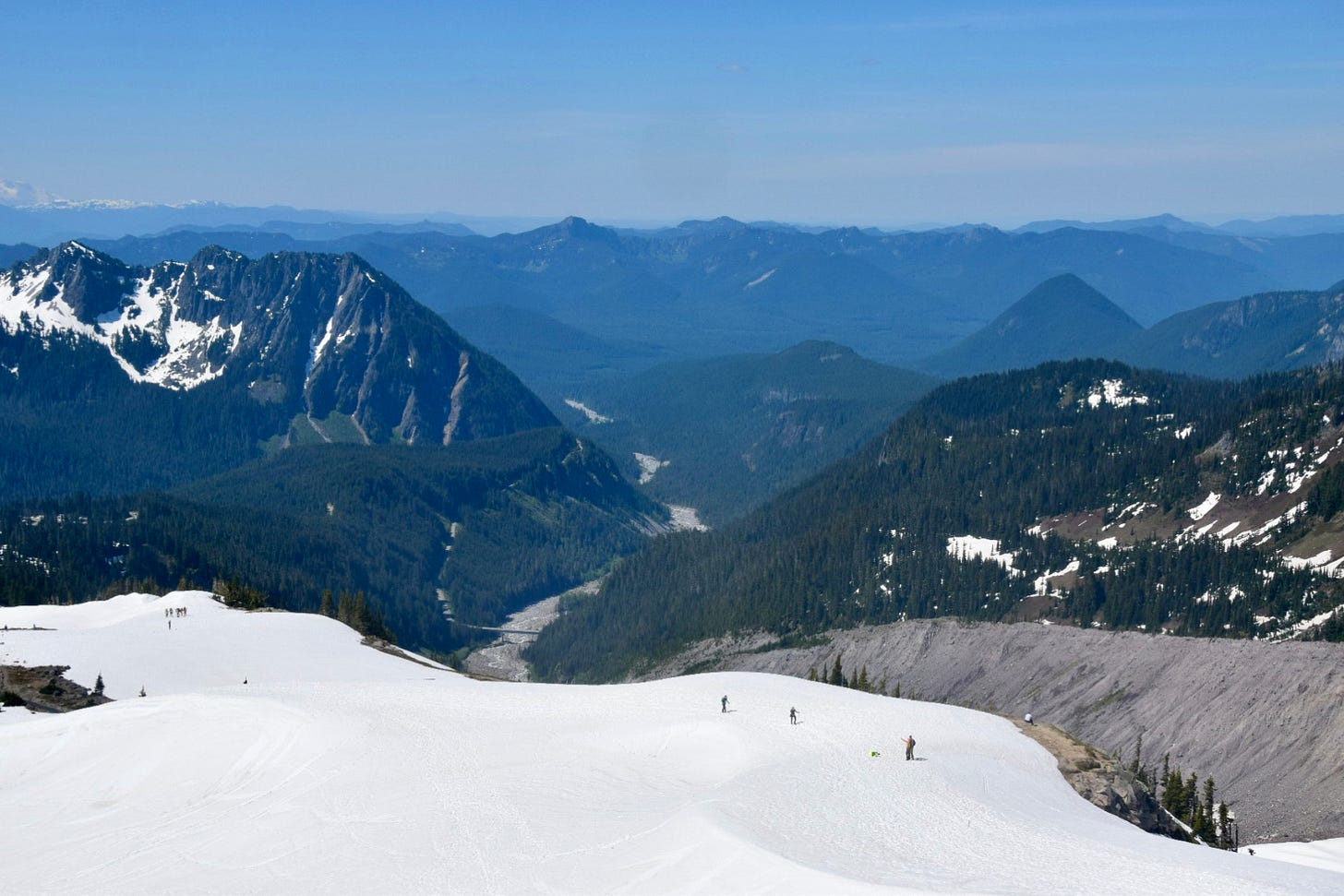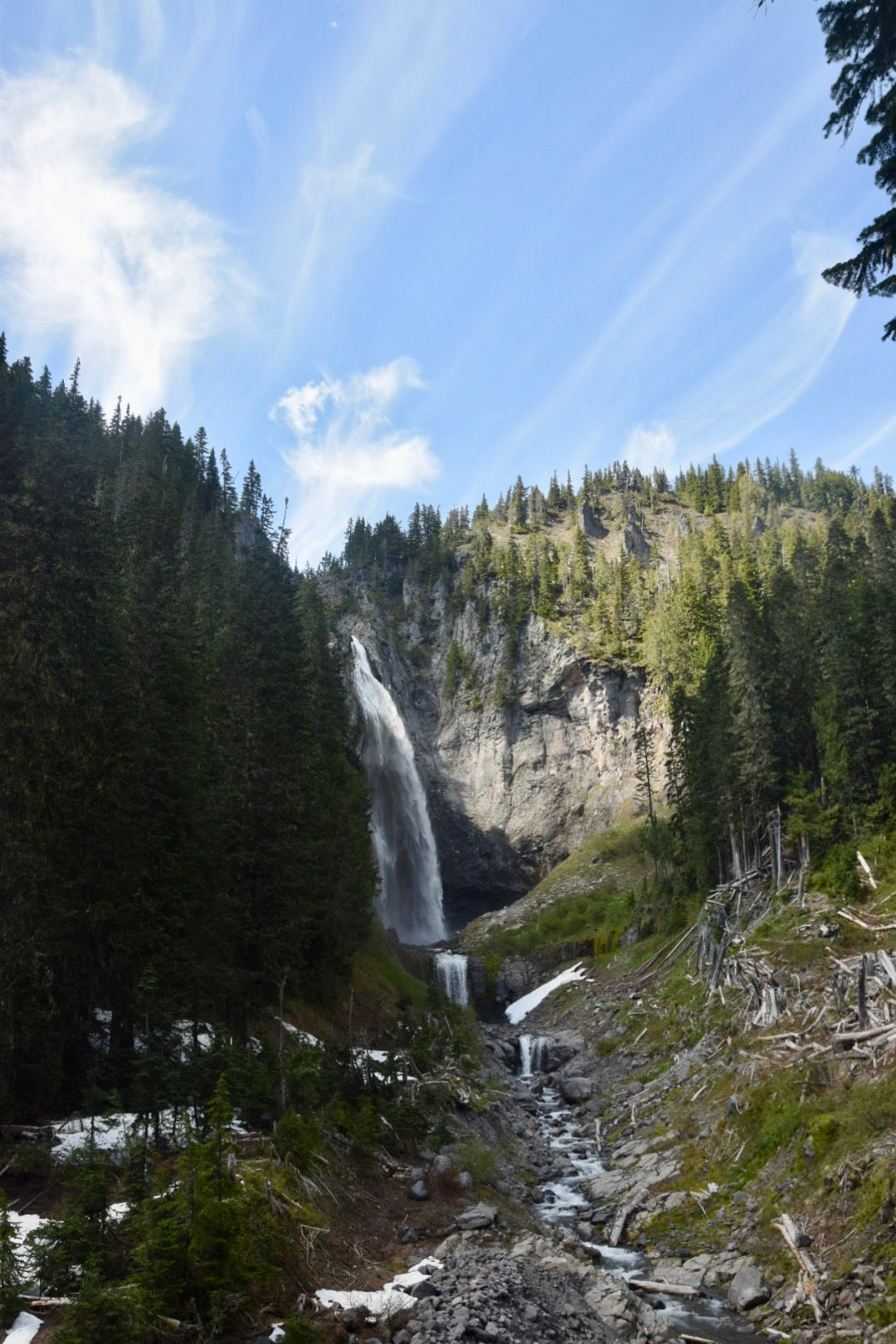“Did you hear what happened to him last week? He went to slide down the slope but all the snow had turned to jagged ice. It tore his legs all up!”
We listened to the two snowboarders perched on the boulders just above us. Further up the trail several hikers could be seen sliding down the embankment, opting for a quick plunge on their backsides rather than cautiously stepping down. A couple had just asked the boarders how to properly go about this action and they had offered their advice, mostly about controlling speed and avoiding crashing into boulders. They had neglected to mention the dangers of jagged ice until after the couple had left.
Legs rested, snacks consumed, and views taken in, Chelsea and I rose off our rocky perches at Panorama Point, 1,300 feet above where we had begun our snowy hike in the Paradise parking lot. We wouldn’t be completing the Skyline Loop on the steep sides of Mount Rainier, instead retracing our climb up and turning it into an out-and-back. Without poles and crampons, venturing any further into the wilder side of the loop in the June snow was too risky a proposition.
We already knew the way down wasn’t going to be a breeze. Technically we were hiking several feet above the actual trail thanks to the snowpack, which made the narrow ledges even skinnier and less stable at certain points. At times a shoe’s width stood between our feet and the ground 400 feet below.
Shortly down this narrow path we encountered the inquisitive couple standing at the top of a steep incline, debating whether to just slide down the side instead of winding down the trail. The way down looked near vertical, but mostly free of rocks and there was evidence others had tried this same route previously.
“What do you guys think?” they asked as we walked by.
“I mean it looks like some other people have done it. There doesn’t seem to be anything in the way. We’re going to keep hiking down, but you guys have fun!” I replied.
As we continued down the trail, we heard the couple commence plunging down the side and watched them safely come to a stop several hundred feet down. It sure looked like fun. When we stopped at the top of of the last part of our climb down, a narrow set of stairs where we would need to wait for a group of people coming up, Chelsea turned to me and said, “Do you want to try it?”
To our left the edge sloped down less severely and not quite as far as where the other couple had descended, a bunny hill for butt-sliding. “Yeah, let’s try it!”
It was like being a kid again, sledding into the ditch beyond my backyard. Leaned back, pack on my stomach, feet raised to reduce friction, I cruised down the slope. Before too long the loose powder collecting in front of my backside had brought me to a stop. One hundred, two hundred feet, I hadn’t went far. Chelsea followed behind.
We stood up, brushed ourselves off, and resumed our more conventional walk down the mountain. A mile later we were back in the parking lot, June sun warming us as we passed around a well-earned Rainier beneath its namesake peak.
The Park
In 1899, Mount Rainier became the fourth national park in the United States. Its 369.3 square miles protect Mount Rainier, at 14,410 feet the tallest mountain in the Cascade Range, as well as its surrounding valleys, waterfalls, meadows and, old-growth forests. The park is home to the Carbon Glacier, the largest by volume in the contiguous United States, and the Emmons Glacier, the largest by area in the contiguous United States.
The park is a fantastic example of the rustic-style of national park architecture, exemplified by the Paradise Inn and many other structures preserved from the 1920s and 1930s.
The park can best be thought of as two main sections - Paradise and Sunrise (Longmire is considered separate from Paradise but it’s in the same general southern part of the park and passed by on the way to Paradise if coming from the southwest entrance). Thanks to a general lack of roads and the impediment of a mountain in between them, it’s best to visit the Paradise and Sunrise areas on separate days. The main park roads run from the southwestern corner along the southern edge of the park to the southeast corner and then turn north to exit out the park in the northeast corner. Thanks to enormous amounts of snowfall, several of the roads are closed in the winter (including those east of Paradise and the road to Sunrise).
Paradise is on the southern slope of Mount Rainier, It’s the most popular destination in the park, home to the Paradise Inn, and the launching point for premier day hike in the park, the 5.7-mile Skyline Loop that offers stunning views of the summit and the surrounding land. More family-friendly hikes like the 1.2-mile Nisqually Vista Trail, the 2.5-mile Bench & Snow Lakes Trail, and the 1-mile portion of the Skyline Trail to Myrtle Falls can also be found here.
Longmire offers lots of short loops, like the 0.7-mile Trail of the Shadows and the 0.4-mile Twin Firs Loop Trail, and plenty of history in the National Park Inn and the Longmire Museum. Longmire is as much about the old-growth forests as it is the mountain itself.
Sunrise offers up views of the northern side of the mountain. The premier trail here is the 5.7-mile Mount Fremont Lookout Trail. The Emmons Vista and Silver Forest Trail provide views of the White River Valley, the Emmons Glacier, and Mount Rainier over 1.6 miles. The 7-mile Glacier Basin Trail provides a rainbow of wildflowers during the summer.
The 5.6-mile Tolmie Peak Trail is accessed in the more remote northwestern corner of the park. The 3.5-mile round trip portion of the Van Trump Trail to Comet Falls is another lesser traveled trail that gets away from the crowds about midway between Longmire and Paradise.
For the ultimate adventure, the 93-mile Wonderland Trail encircles the mountain and provides a multi-day traverse of the park. The trail generally takes about 10 to 14 days to complete thanks to 22,000 feet of elevation gain as you traverse over many of the mountain’s ridges.
Side Trips
Depending on where you’re located in the park, Seattle is only about an hour and a half away. From the southwest entrance, Portland is a little over two hours. North Cascades National Park and Olympic National Park can be reached in about three hours if you’re looking to hit multiple in one trip.
The area right around the park is very rural and remote. Take advantage of the local produce and grab some cherries from one of the numerous roadside tables that pop up in season.
The Beer
There aren’t many breweries easily accessible from inside the park.
Timber Patch Brewing is about a half hour from the southwest entrance in the town of Morton. It offers a limited selection of classic brewpub styles.
Packwood Brewing Co. and Longmire Springs are both located in Packwood, about a fifteen-minute drive from the southeast entrance. Both breweries brew a wide variety, with a little more variation than the classic brewpub. Ultimately the breweries in this area are as much local watering hole as anything, so they’re looking to cater to everyone rather than finding very specific niches.
The outskirts of Tacoma host around a dozen breweries and can be reached in around a half hour from the lesser-visited northwest corner of the park.
Keep in mind that with winter road closures, these distances can be an hour or more longer.
What I’ve Been Enjoying Lately
Soldiers and Kings by Jason De León was a really quick 300+ page read. The 2024 Pulitzer Prize winning book for nonfiction revolves around the author’s time spent with several human smugglers in Mexico. It breaks the tired tropes and stereotypes and left my heart wrenched. Migration is a massive issue with so many underlying causes and the only definitive solution is that it’s not what we’re currently doing.
Steven Levitsky and Lucan A. Way have spent their lives studying democracy and have frequently been right in their past analysis of where we’re heading as a country. The future they lay out in The Path to American Authoritarianism isn’t pretty and now more than ever we need to be paying attention. The biggest divide in politics right now isn’t between the left and the right, it’s between those that are actually paying attention and those that think ignorance is bliss.
I spent most of last Thursday laid up on the couch with a nasty cold and little desire to do much reading. Perfect time to start a series I’ve had on my list for awhile - Barry. And by start, I mean I had finished all four seasons by Saturday. Bill Hader’s darkly funny hitman searching to remake himself as an actor masters the art of closing each episode in a way that makes you want to just keep watching, which is exactly what I did.













